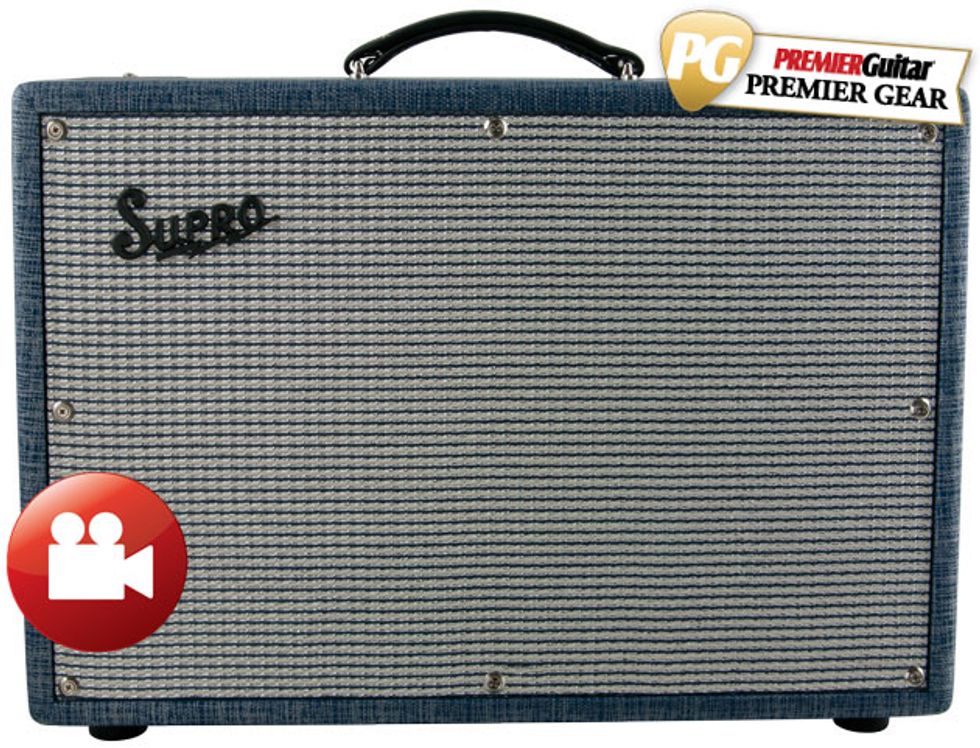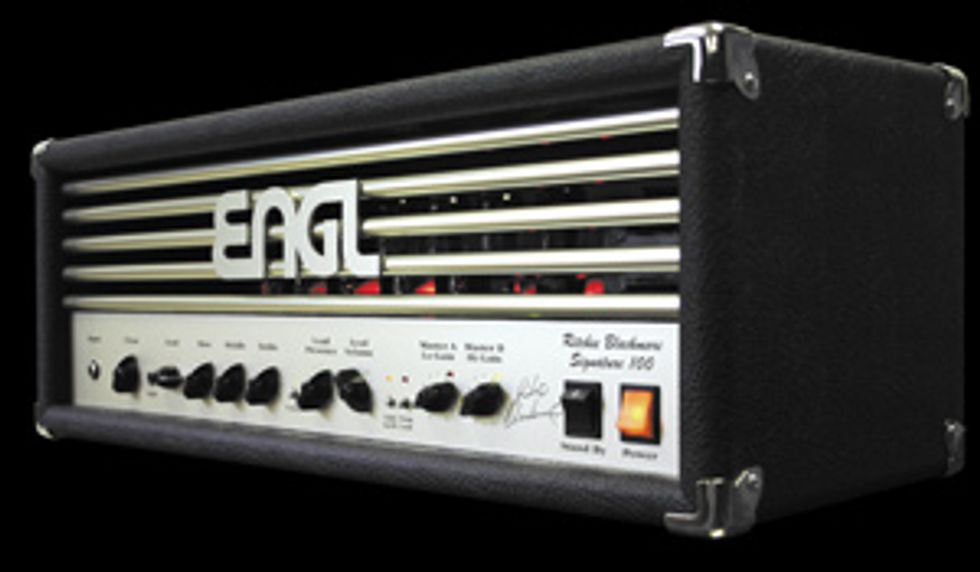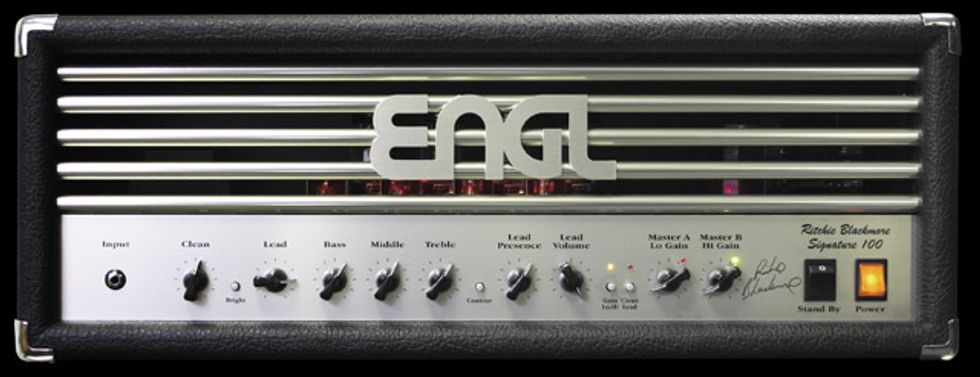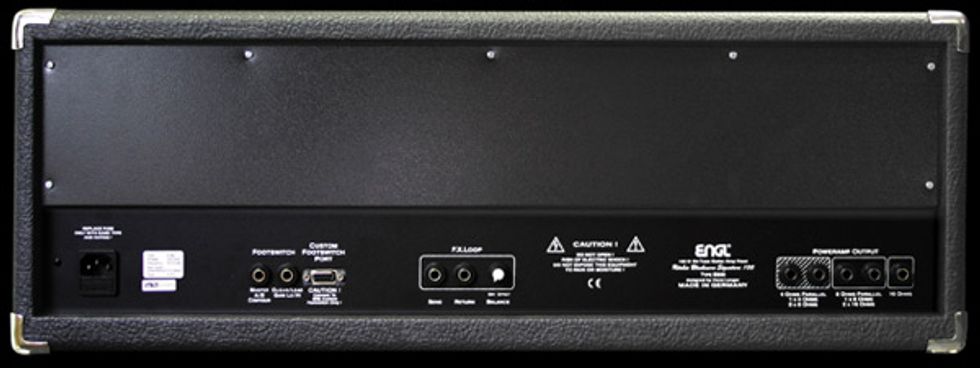The smallest of the new-school Supros isn’t based on a vintage model, but it nails that punky, budget-box attitude.

The original Supro amps were produced by Valco and sold through department stores in the ’50s and ’60s. Despite their built-for-beginners status, these humble amps have often served as secret weapons for great guitarists, notably Jimmy Page during Zep’s early years. Supros lack the power of Marshalls and the rich, balanced tones of Fenders, but their explosive presence and rude overdrive have lent a punky edge to many great recordings.
Valco folded in 1968. But about a decade ago, famed amp designer Bruce Zinky revived the brand. The Supro name changed hands a few years ago, and now Dave Koltai of Pigtronix fame runs the show, releasing new Supro models while retaining many of Zinky’s innovations.
New Supros aren’t clones—they’re made from modern materials using modern manufacturing techniques. But don’t mistake them for generic amps with a bit of retro-cool window dressing. Consider the new Saturn combo: It’s not based on a particular vintage model, and its innards are strictly 21st-century. Yet it nails the unvarnished aggression of the best Supro combos while adding meaningful refinements. If you love the Led Zeppelin I sound, chances are you’ll dig this amp.
Vintage Modern
The U.S.-made Saturn is the smallest amp in the current Supro line, a single-channel combo with tube reverb and tremolo. It puts out 15 watts via a pair of 6973s—tubes found in many second-tier ’60s brands, and currently experiencing a bit of a renaissance. (The rectifier tube is a vintage-accurate 5U4.) Saturn’s solid-wood cabinet houses a 12" custom-voiced Eminence speaker. The amp’s controls are simple: volume, bass, treble, reverb level, and tremolo rate/depth. The knobs, logo, grille, and “rhino hide” vinyl provide an authentic ’60s look.
Inside is a different story: Parts are assembled on a pair of modern circuit boards, with board-mounted pots and jacks. (The components in old Supros are linked via terminal strip.) The boards are oriented at a 90-degree angle to each other, with some tubes pointing down toward the floor and other face inward toward the speaker, though they’re all accessible without disassembling the amp. The transformers are custom-made to Zinky’s specs.
But despite its modern construction techniques, Saturn’s creators seem to have designed the amp with reverence for the colors and quirks that make Supros special.
Biased for Badness
Like old Supros, Saturn is a cathode-biased “Class A” amp, and the trademark qualities of that architecture are front-and-center here. Tones are lively, responsive, and loose. Highs crackle with energy. The amp transitions to distortion at relatively low levels.
On the other hand, Saturn isn’t particularly loud. It’s definitely powerful enough to annoy your neighbors, but it may not be sufficiently beefy for gigs with aggressive drummers unless you have good monitors and a reliable sound person. You can pretty much forget about obtaining crystalline tones at anything more than modest volume. And while Saturn’s lows aren’t thin, they’re hardly weighty—this amp doesn’t do “chunk.” (Actually, modern Supros tend to have noticeably stouter lows than original models, but still, don’t expect to see many metal players using them. However, blues hounds, early Zep freaks, antique R&B aficionados, and indie troublemakers will probably relish this sound.)
For the players likeliest to cherish amps of this type, these traits are features, not bugs. Saturn doesn’t thump like a Marshall or spank like a Fender, and that’s part of the point. Instead, you get blunt, ultra-present attack and an attitude I can only describe as “snotty” (in the best possible punk-rock sense). Tones tend to feel literally in-your-face in that “Communication Breakdown” way. And recording guitarists will love how Saturn delivers high-octane overdrive at relatively low levels.
Set the Controls for … Whatever
Saturn’s 2-band tone controls are limited but effective. The bass pot’s taper is a bit odd—lows come on suddenly and strongly at around 10 o’clock, as opposed to easing in gradually. But chances are you’ll just dial in a setting that suits your pickups and park it there. Meanwhile, like the best small Fender tweeds, Saturn boasts phenomenal dynamic response.
Ratings
Pros:
Vibey Valco tones with meaningful improvements.
Cons:
Not cheap for a circuit-board amp. Footswitch not included.
Tones:
Ease of Use:
Build/Design:
Value:
Street:
$1,400
Supro 1648RT Saturn Reverb
suprousa.com
Many users will simply turn the amp up till it growls and then scarcely touch the thing, sculpting tone via their hands and guitars. In fact, players of this persuasion are likeliest to dig Saturn the most.
For all the snippets in my audio demo (see the online version of this review), I simply set the tone controls at noon, advanced the volume 80%, and then scarcely touched the amp except to tweak the reverb and tremolo. I felt no need to alter the volume or tone settings, even when switching between the ’63 Strat, ’80s Les Paul, and Gretsch-like “parts” guitar heard in the demo clip.
Wet and Wobbly
A hefty, four-spring tank delivers gooey-good reverb. The tremolo is equally lovely, if quirky in a signature Supro way. It’s relatively restrained—maximum settings throb, but never chop. Also, the response varies according to the volume settings.
Again, these are features, not bugs: As Dave Koltai explained to me, these traits are inevitable side effects of the Supro circuit, which employs output-tube tremolo, and whose modulation depth is limited by the cathode-bias architecture. Want to play an accurate cover of “How Soon Is Now?” Get a damn Twin Reverb. Meanwhile, I dig how Saturn delivers a cool variation on the familiar Fender flavor. You can toggle the reverb and tremolo via footswitch (sold separately).
The Verdict
Saturn delivers a great mid-century American sound in an authentic-sounding but technologically innovative way. Some might balk at spending $1,400 on a small, circuit-board amp, but Supro didn’t simply clone some vintage circuit—Saturn’s creators clearly invested much time and ingenuity in capturing a classic color while delivering such meaningful improvements as lower noise, greater bass response, and roadworthy construction. At this price, you could buy an original Valco amp—maybe more than one. But frankly, Saturn is likely to sound better than any of them, and it definitely stands a better change of surviving the stage and the van. It’s a compelling option for guitarists seeking cool vintage tones from outside the Fender/Marshall/Vox axis.
Watch the Review Demo:
The PRS Sweet 16 amp can deliver tones for any style without relying on the classics
| Download Example 1 Clean - Bright Off, Volume 7 o'clock, Reverb 10 o'clock, Treble, Middle and Bass at noon, Master 11 o'clock. Fender VG Strat. | |
| Download Example 2 Head then Combo with same settings - Bright on, Volume 5 o'clock, Reverb off, Treble 3 o'clock, Middle noon, Bass 2 o'clock, Master 10 o'clock. PRS Mira X. | |
| Download Example 3 Classic Rock - Bright on, Volume 3 o'clock, Reverb off, Treble 1 o'clock, Middle 2 o'clock, Bass 11 o'clock, Master 8 o'clock. PRS Mira X. | |
| All clips recorded with a Shure SM57 with Digidesign Pro Tools | |
Sweet Simplicity
The Sweet 16’s simple controls include volume, treble, mid, bass, master volume and a bright switch. The preamp section consists of two 12AXT tubes and two 12AT7 tubes. The power tubes are biased to near Class A, so they run a bit hotter than normal. There is also a tube-driven 3-spring Reverb with a medium decay. The back panel of the Sweet 16 stays simple as well, with only an impedance selector and speaker outputs.
Plug In
I hooked up the Sweet 16 to one of the new Paul Reed Smith 1X12 speaker cabinets, and cranked the volume up all the way for a distorted tone. The Master Volume was set fairly low and all parameters were set to 12 o’clock. I plugged in a variety of humbucker-equipped guitars, such as a Schecter Horton with Seymour Duncans, an Ibanez 540 with EMGs and a PRS Mira X. Power chords were fat and chunky, with plenty of bite. I was able to get a good distortion with a classic British rock vibe immediately, without even spending any extra time knob twiddling. It was a nice, thick and smooth overdriven tone, with a fat controlled bass and a strong mid character. The Sweet 16 offers a voicing that can’t easily be compared to a sound such as a Marshall or a Vox. It has its own thing going on, which is a good thing. I have to say I was pleasantly surprised at how robust the volume and tone are with the Sweet 16, which proves that good things do come in small packages!
I really liked how responsive the Sweet 16 was, depending on how hot the pickups are. With each guitar I tried, the tone was sweet and warm with a very musical distortion when pushed hard. Backing off on the guitar’s volume, the Sweet 16 proved to be quite touch-sensitive. You can start off with a clean tone, and the amp reacts well to the velocity of your strumming by adding a touch more crunch and bite when you dig in a little harder. A guitarist will appreciate being able to control the amp just by the attack of the pick or a turn of the guitar’s volume knob.
The Sweet 16 sounds great with single-coil pickups as well. With a clean tone, the highs were crisp and sparkly but also had plenty of warm and boomy low end to round out the sound. It offered great tones for blues, funk and country playing. I really liked the sound of my Strat’s single-coil in the neck position, for playing either rhythms with a clean sound, or leads with a more distorted tone. Also, the “edge of breakup” tone to full distortion sounded great with a Strat. The tone remained clear without getting too fuzzy or muddy.
You can clearly hear the range of certain parameters when using a clean sound. The bright switch definitely adds more shimmer and sparkle for more bell-like cleans. Also, the bass control is more useful in the clean setting. I found that turning up the bass a lot in overdrive made the tone a little too rumbling and buzzy for my liking.
The Combo
I was able to test out the Sweet 16 combo amp as well as the head. The combo has the exact same features and control panel as the head version, and includes a Celestion G12H-30 speaker. The amp’s sound is basically the same, although there was a slight difference in tonality between the combo amp and the head & cabinet combination. The new PRS closed-back 1X12 cabinet features a Vintage 30 speaker. Paired with the Sweet 16 head, this combination results in a very large-sounding and resonant tone. There was a really ballsy sound and bass response from this cabinet that I really liked and preferred over the combo version.
The Final Mojo
The Sweet 16 has tones that will please any rock, blues, country or jazz player. You won’t get an instant high-gain metal sound with the amp alone. However, I tried the amp with a high gain pedal and a guitar with active EMG pickups, and the amp was instantly transformed into a modern metal machine! So it is versatile enough that a guitarist can use this amp for a jazz session one day, and a metal gig the next day. (And yes, I do know many guitarists who work like that!)
Overall, I thought the Sweet 16 was amazingly well balanced, with really nice overtones. Guitarists will appreciate its portability, and can be used in the studio or on stage, as well as backstage or at home. It’s priced lower than other PRS amps, so it’s like getting a boutique amp without the big price tag. The Sweet 16 a small, single-channel, low-wattage amp with great tones and good looks, and is definitely an amp worth checking out.
Buy if...
You’re looking for a boutique quality amp at a reasonable price
Skip if...
You need an amp with an FX loop or more than one channel
Rating...
Head MSRP $1999 Street $1659 - PRS - prsguitars.com |
Engl''s Ritchie Blackmore Signature combines gain with clarity at an reasonable price.
 | |
| Download Example 1 | |
| Download Example 2 | |
| Recorded with 2006 Gibson Flying V | |
Blackmore’s unique guitar tone was a combination of the best of both worlds. Originally achieved with a Fender Stratocaster with a scalloped fretboard (purchased from a roadie of Eric Clapton’s) into modified Marshall Major 200-watt heads, it had the cut and tightness of the Strat and the heft, thickness and power of the Marshall Major. Since 1994, Blackmore has been using amplifiers from Engl. More recently, his own signature model was released to try to replicate the sheer power of his past rig and offer a larger, more modern tonal palette.

Larger Image
Features
The E 650 head presents the player with a relatively simple layout, consisting of a 3-band EQ section with a Presence control. A total of four channels share this circuit, and can also utilize the included Bright and Contour switches (more on this later). Along with a separate Lead Volume control and two Master Volume Controls, each channel setup reacts differently, depending on how the amplifier is set. The amplifier is all tube, running a quartet of 5881 power tubes and a total of four ECC83 preamp tubes.
Plugging In
After setting up the head with the matching Engl PRO series 4x12 cabinet, the head was set with the EQ controls at the 12 o’clock positions, the clean channel engaged, and fed with the input from a 1978 Gibson Les Paul Custom and a 2006 Fender American Stratocaster. Two words can best describe this channel: intense power. Older-era single channel Marshall amps, especially the Marshall Major, had a reputation for pushing a lot of air even when clean. Certainly, one of the defining characteristics of the Major was the added headroom; it was a very difficult amplifier to distort because it was extremely loud. It was certainly a shock to hit an open G chord and feel that old school non-master volume amp punch in the chest—that feeling that lets you know this is a healthy amplifier with a lot of power underneath the hood. This channel can be pushed into a light crunch more easily than a non-master volume amp by using the preamp gain control knob in tandem with the Master Volume A control, but it isn’t necessary. Pressing the “Gain Lo-Hi” button shoved out a killer British drive tone capable of handling any seventies rock tone you could want. In addition, the channel still had the punch and cut of the stock clean channel— the great vibration that exudes from a welldesigned amplifier, and that you can feel in your chest. The surprises did not stop there, though; this amp had a lot more say as the trial pressed on.
The lead channel section in the Blackmore has a somewhat different feel from the more unsoiled half. While the clean side has a very immediate attack with an extremely muscular tone, the lead channel gives in, just a little, for a spongier feel. It certainly doesn’t lose its defined punch, clarity and grind. Rather, it makes the amp a little easier to play, which is very nice, considering how much gain this thing has. For rock players of all eras, this is a great amplifier, but it is especially so if seventies hard rock is in order.
If more modern metal is what you’re after, the Engl Blackmore can hold its own against pretty much anything. The drive is rich, thick and enormously clear, sounding better and better as the master is turned up. Make no mistake, the Blackmore sounds great at low volumes, but sounds out of this world when pushed hard. It surely shares the tonal hi-fi ranks of other brilliant European amp makers, such as Diezel. It has that great British high gain tone with perfect midrange, but melded with modern, high fidelity circuitry and a particularly efficient power section. In the world of guitar tone, this is a relatively new sound and feel. Some players don’t care at all for the hi-fi quality of these amps, while others have been waiting their whole careers for something to come along that does it. Obviously, the best bet would be to play one in person, simply because the Engl Ritchie Blackmore is a very punchy and uniquely-voiced amplifier.

The lead channels are the only channels where the Contour control has any affect in the circuit. When pushed in, the frequencies between 300 and 500 Hz are boosted, providing a nice cutting edge for the toneto make its way through the mix, with plenty of harmonics for fast, easy runs. The Lead channels can also be further tweaked with the Presence and separate Lead Volume controls, which help add a sparkling top and balance the levels between the two channels. When reaching the higher gain settings, the amp handles modern metal and thrash tones with ease.
The Final Mojo
The Blackmore is a high gain player’s amp. That being said, players should definitely take warning: the impressive amount of gain coupled with the intense clarity will not cover up any lack of detail in the player’s style. Considering the price of the amplifier, the number of tones available and the simplicity of the features, some could easily consider it a bargain. There are other amplifiers that have similar tones but cost a lot more than this particular model. Without a doubt, it will make you feel, as Ritchie Blackmore himself put it years ago, “like you own the stage.”
Buy if...
you want a loud, reliable, efficient high-gain amp with a high fidelity feel for a great price.
Skip if...
you consider the hi-fi tones too anemic, need less power or separate EQ control for each channel.
Rating...
Street $1699 - Engl - engl-amps.com |
